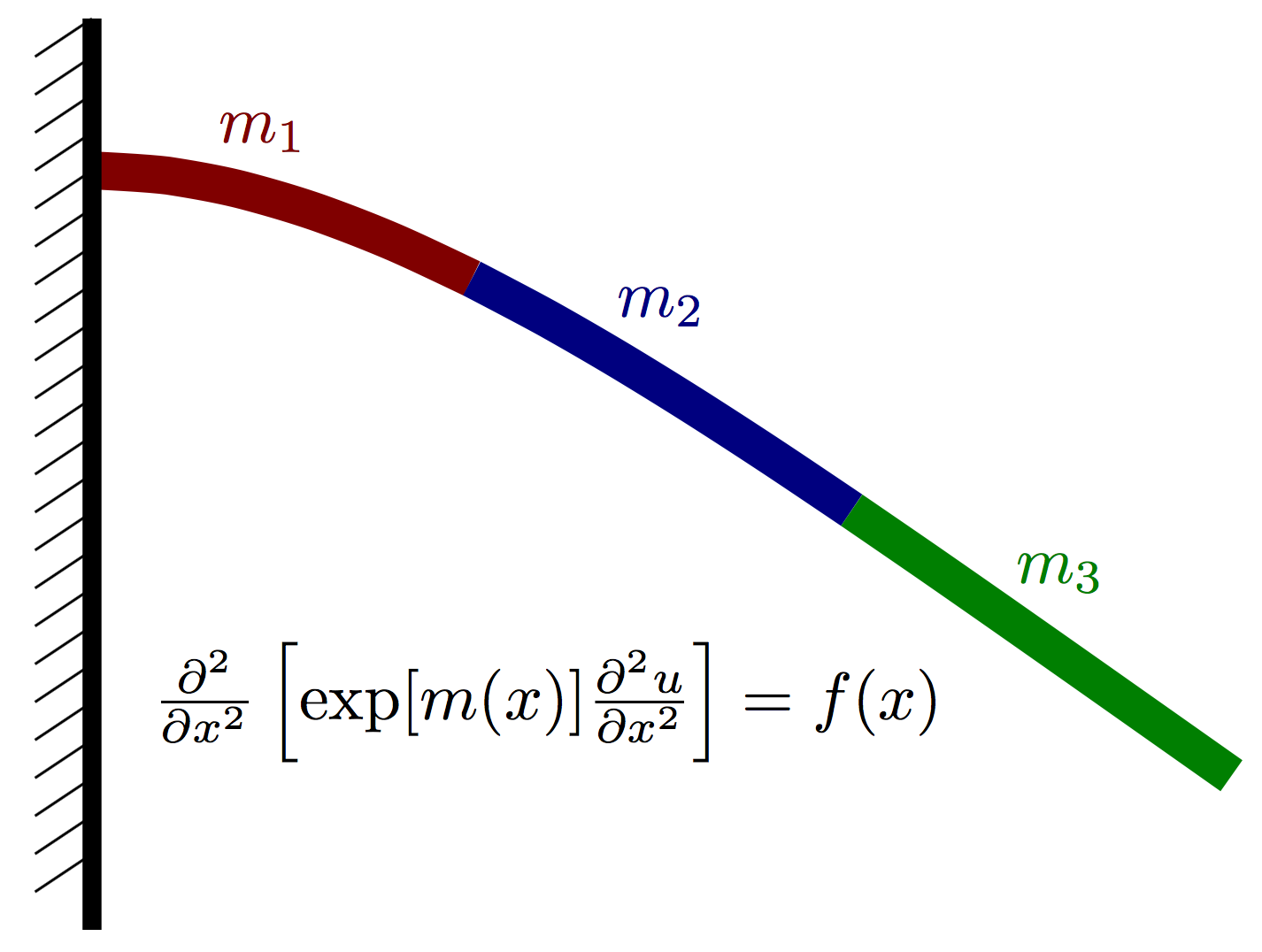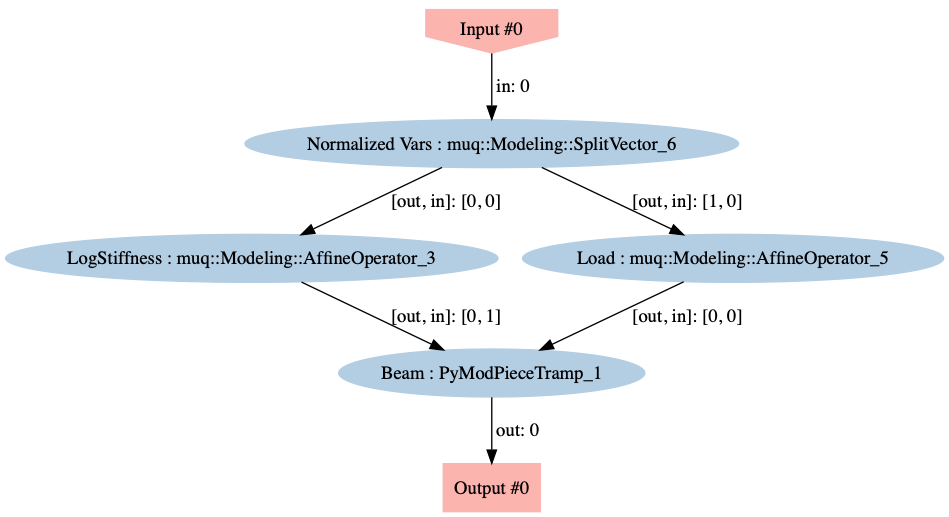Example Mixed PCE Construction
Construction of polynomial chaos expansions with inputs that have different distributions.
Problem Description
Construction of polynomial chaos expansions with inputs that have different distributions.
Problem Description
This example uses an Euler-Bernoulli beam model to illustrate the use of generalized polynomial chaos (gPC) for forward uncertainty quantification. Uncertainties in the stiffness of the beam and load applied to it are represented probabilistically with different distributions (lognormal and uniform) and the distribution of the displacement is represented with an appropriate polynomial expansion.

Model Formulation:
Let $u(x)$ denote the vertical deflection of the beam and let $f(x)$ denote the vertical force acting on the beam at point $x$ (positive for upwards, negative for downwards). We assume the displacement of the beam can be well approximated using Euler-Bernoulli beam theory and thus satisfies the PDE $$ \frac{\partial^2}{\partial x^2}\left[ \exp[m(x)] \frac{\partial^2 u}{\partial x^2}\right] = f(x), $$ where $K(x)=\exp[m(x)]$ is an effective stiffness that depends both on the beam geometry and material properties. Our goal is to probabilistically characterize uncertainty in the displacement $u(x)$ that is caused by uncertainty in the log stiffness $m(x)$ and load $f(x)$. Note that any model error stemming from the form of the Euler-Bernoulli PDE is ignored in this example.
The left end of beam is fixed and has boundary conditions $$ u(x=0) = 0,\quad \left.\frac{\partial u}{\partial x}\right|_{x=0} = 0. $$ The right end of the beam is free and has boundary conditions $$ \left.\frac{\partial^2 u}{\partial x^2}\right|_{x=L} = 0, \quad \left.\frac{\partial^3 u}{\partial x^3}\right|_{x=L} = 0. $$
We assume that $m(x)$ is piecwise constant over $P$ nonoverlapping intervals on $[0,L]$. More precisely, $$ m(x) = \sum_{i=1}^P m_i \,I\left(x\in [a_i, a_{i+1})\right), $$ where $I(\cdot)$ is an indicator function. We further assume that $f(x)$ is constant for all x and takes a fixed value, denoted simply by $f$.
A finite difference discretization of this model is implemented as a child of ModPiece in BeamModel.py. The details of the finite difference discretization are the scope of this example, but can be found in the documentation of the BeamModel class.
Input Distributions
For the prior over the piecewise constant values $m_i$, we assume each variable is independent and normally distributed, i.e., $$ m_i \sim N(\mu_i, \sigma_i^2). $$ We further attribute the load random variable $f$ with a uniform distribution $$ f\sim U\left[f_{lb}, f_{ub}\right] $$
Imports
import muq.Modeling as mm import muq.Utilities as mu import muq.Approximation as ma import numpy as np import matplotlib.pyplot as plt from BeamModel import BeamModel
Define the model
numNodes = 100 # Number of finite difference nodes in discretization
nodeLocs = np.linspace(0,1,100) # Finite difference node locations
numBlocks = 3 # Number of stiffness blocks ("P" in description above)
dim = numBlocks + 1
beam = BeamModel(nodeLocs, numBlocks)
[0, 33, 66, 101]
Evaluate the model
The following cell evaluates the Euler-Bernoulli model for some arbitrary stiffness and load inputs.
logStiffness = [8.0, 5.0, 2.0]
load = [-0.01]
displ = beam.Evaluate([load, logStiffness])[0]
plt.plot(nodeLocs,displ)
plt.xlabel('Position along beam')
plt.ylabel('Beam displacement')
plt.show()
Set up the model for PCE construction
To evaluate the Euler-Bernoulli beam model above, two inputs were to the Evaluate function. MUQ's PCE factory, however, only functions with models that have a single input. The distribution of each component of the model input must also match a standard polynomial family according to the Askey scheme [Xiu and Karniadakis, 2002]. For continuous random variables, the Askey scheme is
| Distribution | Polynomial Family | Support |
|---|---|---|
| Standard Normal | Probabilist Hermite | $(-\infty,\infty)$ |
| Uniform | Legendre | $[-1,1]$ |
| Gamma | Laguerre | $[0,\infty)$ |
| Beta | Jacobi | $[0,1]$ |
To handle more general Gaussian and uniform distributions, we need to scale the these "normalized" distribution into the inputs of the Euler-Bernoulli beam model. This can be accomplished with a combination of MUQ's AffineOperator and DiagonalOperator classes.
Let $\theta = [z_1,z_2,z_3,u]$ be a vector "normalized" variables. We want to set up a series of operations that splits this vector (using the SplitVector class) into the Gaussian components $z_1,z_2,z_3$ and the uniform component $u$ before scaling and shifting the components to match the distributions over the beam stiffnesses $m_i$ and load $f$. For $m_i \sim N(\mu, \sigma^2)$, the transformation
$$
m_i = \sigma z_i + \mu
$$
is employed. Similarly, for $f\sim U\left[f_{lb},f_{ub}\right]$, the transformation
$$
f = \frac{1}{2}\left[(f_{ub}-f_{lb})u + (f_{lb}+f_{ub})\right]
$$
is used.
logStiffMean = [8.0, 8.0, 8.0] logStiffStd = [1.5, 1.5, 1.5] fub = -0.0 flb = -0.1 loadMean = [-0.05] loadScale = [0.05] stiffTransform = mm.AffineOperator(mm.DiagonalOperator(logStiffStd), logStiffMean) loadTransform = mm.AffineOperator(mm.DiagonalOperator([0.5*(fub-flb)]), [0.5*(fub+flb)])
To combine the split, shift, scale, and solve operations, we employ an instance of the MUQ WorkGraph to connect the operations.
graph = mm.WorkGraph()
graph.AddNode(mm.SplitVector([0,numBlocks],[numBlocks,1],dim), "Normalized Vars")
graph.AddNode(stiffTransform, "LogStiffness")
graph.AddNode(loadTransform, "Load")
graph.AddNode(beam, "Beam")
graph.AddEdge("Normalized Vars",0,"LogStiffness",0)
graph.AddEdge("Normalized Vars",1,"Load",0)
graph.AddEdge("LogStiffness",0,"Beam",1)
graph.AddEdge("Load",0,"Beam",0)
model = graph.CreateModPiece("Beam")
Visualizing the WorkGraph is a good way to ensure that the graph was constructed properly.
graph.Visualize('ModelGraph.png')

Define the PCE factory
The next step is to create an instance of the AdaptiveSmolyakPCE class, which will evaluate the model and construct the PCE. This class implements the adaptive pseudo-spectral technique described in Conrad and Marzouk, 2013 and requires us to define the polynomial families used in each direction (according to the Askey scheme above) as well as the quadrature rules used in the adaptive algorithm. The weight used in the quadrature rule should match the distribution of the input. For example, we employ a Gauss-Hermite quadrature rule in the Gaussian dimensions and a nested Gauss-Patterson rule in the uniform direction.
# Define the Polynomial families for each input dimension gaussPoly = ma.ProbabilistHermite() uniformPoly = ma.Legendre() polys = [gaussPoly]*numBlocks + [uniformPoly] # Define the 1D quadrature rules used for each input dimension. # Gauss-Hermite in the Gaussian directions and Gauss Patterson in the uniform direciton. gaussQuad = ma.GaussQuadrature(gaussPoly) uniformQuad = ma.GaussPattersonQuadrature() quads = [gaussQuad]*numBlocks + [uniformQuad] # Create the Adaptive Smolyak Solver smolyPCE = ma.AdaptiveSmolyakPCE(model, quads, polys);
Construct the PCE
The following cell is where the model is actually evaluated and the PCE is constructed. The multivariate polynomial terms used in the PCE are tracked through a set of multiindices. Here, using the multis variable, we set the initial terms in the expansion to include all of the linear polynomials.
Internally, the pseudospectral algorithms approximates the $L_2$ error of the polynomial approximation and stops adapting if the error estimate drops below the ErrorTol specified in the options dictionary below.
# Start with a linear approximation initialOrder = 1 multis = mu.MultiIndexFactory.CreateTotalOrder(dim,initialOrder) options = dict() options['ShouldAdapt'] = 1 # After constructing an initial approximation with the terms in "multis", should we continue to adapt? options['ErrorTol'] = 1e-4 # Stop when the estimated L2 error is below this value options['MaximumEvals'] = 2000 # Stop adapting when more than this many model evaluations has occured pce = smolyPCE.Compute(multis, options);
Inspect the results
print('Number of Model Evaluations:')
print(smolyPCE.NumEvals())
print('\nEstimated L2 Error:')
print('%0.4e'%smolyPCE.Error())
Number of Model Evaluations: 1337 Estimated L2 Error: 9.0184e-05
Plot the convergence diagnostics
The ErrorHistory(), EvalHistory(), and TimeHistory() functions of the AdaptiveSmolyakPCE allow us to inspect adaptation history of the PCE factory. These functions returns vectors with one component for each adaptation iteration.
errorHist = smolyPCE.ErrorHistory() # Estimated L2 error evalHist = smolyPCE.EvalHistory() # Number of evaluations timeHist = smolyPCE.TimeHistory() # Elapsed time
fig, axs = plt.subplots(ncols=3,sharey=True,figsize=(10,4))
axs[0].semilogy(errorHist,'*-')
axs[0].set_ylabel('Global Error Indicator')
axs[0].set_xlabel('Number of Adaptations')
axs[0].semilogy([0, len(errorHist)-1], [options['ErrorTol'],options['ErrorTol']],'--k')
axs[1].semilogy(evalHist, errorHist,'*-',linewidth=2)
axs[1].set_xlabel('Number of Evaluations')
axs[1].semilogy([evalHist[0], evalHist[-1]], [options['ErrorTol'],options['ErrorTol']],'--k')
axs[2].semilogy(timeHist, errorHist,'*-',linewidth=2)
axs[2].semilogy([timeHist[0], timeHist[-1]], [options['ErrorTol'],options['ErrorTol']],'--k')
axs[2].set_xlabel('Runtime (s)')
plt.subplots_adjust(wspace=0.02)
plt.show()
Predictive Uncertainty
Now that we have a polynomial approximation to the Euler-Bernoulli beam model, we can efficiently look at uncertainty in model predictions of displacement.
Because we chose polynoimials that are orthogonal with respect to the input measure, moments of the prediction can be computed directly from the coefficients in the polynomial expansion. This is how MUQ computes the mean and variance in the following cell.
predMean = pce.Mean() predVar = pce.Variance()
fig, axs = plt.subplots(nrows=2,sharex=True,figsize=(10,8))
axs[0].plot(nodeLocs, predMean,linewidth=2.0)
axs[0].plot([nodeLocs[0], nodeLocs[-1]], [0.0,0.0],'--k')
axs[1].plot(nodeLocs, predVar,linewidth=2.0)
axs[1].plot([nodeLocs[0], nodeLocs[-1]], [0.0,0.0],'--k')
axs[1].set_xlabel('Position $x$')
axs[0].set_ylabel('Mean Displacement $E[u(x)]$')
axs[1].set_ylabel('Displacement Variance ${Var}[u(x)]$')
plt.show()
The entire covariance matrix of the displacements can also be computed efficiently.
predCov = pce.Covariance()
plt.pcolor(nodeLocs,nodeLocs,predCov)
plt.xlabel('Position along beam $x$')
plt.ylabel('Position along beam $x$')
plt.title('Covariance of displacement predictions')
plt.colorbar()
plt.show()
In addition to analytically available moments, the polynomial approximation of the beam model can also be much faster to evaluate than the original PDE model. Here, we leverage that fact to estimate quantiles of the predictive distribution with Monte Carlo samples.
numSamps = 4000
samps = np.hstack([np.random.randn(numSamps,numBlocks), np.random.rand(numSamps,1)])
pred = np.vstack([pce.Evaluate([samps[i,:]])[0] for i in range(numSamps)])
qlevels = [10,20,30,40,60,70,80,90]
qs = [np.percentile(pred,qlevel,axis=0) for qlevel in qlevels]
median = np.percentile(pred,50,axis=0)
plt.figure(figsize=(10,5))
plt.fill_between(nodeLocs, qs[0],qs[-1],color='b',alpha=0.1, label='10%-90%')
plt.fill_between(nodeLocs, qs[1],qs[-2],color='b',alpha=0.2, label='20%-80%')
plt.fill_between(nodeLocs, qs[2],qs[-3],color='b',alpha=0.3, label='30%-70%')
plt.fill_between(nodeLocs, qs[3],qs[-4],color='b',alpha=0.4, label='40%-60%')
plt.plot(nodeLocs,median,'-k',label='Median')
plt.legend()
plt.xlabel('Position $x$')
plt.ylabel('Displacement $u(x)$')
plt.title('Distribution over predicted displacement')
plt.show()
Sensitivity analysis
Decomposing the prediction variance into partial variances stemming from smaller subsets of the input variables. The Sobol index for inputs $i_1,\ldots,i_s$ is the ratio of the variance stemming from just inputs $i_1,\ldots,i_s$ to the total variance. The total sensitivity for a component $j$ is defined similarly, but using partial variances from all terms involving input $j$. As discussed in Section 5 of [Sudret 2008] it is possible to compute these indices directly from the coefficients of a polynomial chaos expansion.
In the cell below, we compute the Sobol indices (also known as main effects) for each input component and all displacements.
mainEffects = pce.MainSensitivity() totalSens = pce.TotalSensitivity()
fig,axs = plt.subplots(nrows=2,ncols=4,figsize=(12,6),sharex=True,sharey=True)
varNames = ['$z_1$', '$z_2$', '$z_3$', '$u$']
for i in range(4):
axs[0,i].plot(nodeLocs, totalSens[:,i])
axs[0,i].set_title('Total wrt ' + varNames[i])
for i in range(4):
axs[1,i].plot(nodeLocs, mainEffects[:,i])
axs[1,i].set_title('Sobol wrt ' + varNames[i])
axs[1,i].set_xlabel('Position along beam $x$')
plt.show()
Completed code:
import muq.Modeling as mm
import muq.Utilities as mu
import muq.Approximation as ma
import numpy as np
import matplotlib.pyplot as plt
from BeamModel import BeamModel
numNodes = 100 # Number of finite difference nodes in discretization
nodeLocs = np.linspace(0,1,100) # Finite difference node locations
numBlocks = 3 # Number of stiffness blocks ("P" in description above)
dim = numBlocks + 1
beam = BeamModel(nodeLocs, numBlocks)
logStiffness = [8.0, 5.0, 2.0]
load = [-0.01]
displ = beam.Evaluate([load, logStiffness])[0]
plt.plot(nodeLocs,displ)
plt.xlabel('Position along beam')
plt.ylabel('Beam displacement')
plt.show()
logStiffMean = [8.0, 8.0, 8.0]
logStiffStd = [1.5, 1.5, 1.5]
fub = -0.0
flb = -0.1
loadMean = [-0.05]
loadScale = [0.05]
stiffTransform = mm.AffineOperator(mm.DiagonalOperator(logStiffStd), logStiffMean)
loadTransform = mm.AffineOperator(mm.DiagonalOperator([0.5*(fub-flb)]), [0.5*(fub+flb)])
graph = mm.WorkGraph()
graph.AddNode(mm.SplitVector([0,numBlocks],[numBlocks,1],dim), "Normalized Vars")
graph.AddNode(stiffTransform, "LogStiffness")
graph.AddNode(loadTransform, "Load")
graph.AddNode(beam, "Beam")
graph.AddEdge("Normalized Vars",0,"LogStiffness",0)
graph.AddEdge("Normalized Vars",1,"Load",0)
graph.AddEdge("LogStiffness",0,"Beam",1)
graph.AddEdge("Load",0,"Beam",0)
model = graph.CreateModPiece("Beam")
graph.Visualize('ModelGraph.png')
# Define the Polynomial families for each input dimension
gaussPoly = ma.ProbabilistHermite()
uniformPoly = ma.Legendre()
polys = [gaussPoly]*numBlocks + [uniformPoly]
# Define the 1D quadrature rules used for each input dimension.
# Gauss-Hermite in the Gaussian directions and Gauss Patterson in the uniform direciton.
gaussQuad = ma.GaussQuadrature(gaussPoly)
uniformQuad = ma.GaussPattersonQuadrature()
quads = [gaussQuad]*numBlocks + [uniformQuad]
# Create the Adaptive Smolyak Solver
smolyPCE = ma.AdaptiveSmolyakPCE(model, quads, polys);
# Start with a linear approximation
initialOrder = 1
multis = mu.MultiIndexFactory.CreateTotalOrder(dim,initialOrder)
options = dict()
options['ShouldAdapt'] = 1 # After constructing an initial approximation with the terms in "multis", should we continue to adapt?
options['ErrorTol'] = 1e-4 # Stop when the estimated L2 error is below this value
options['MaximumEvals'] = 2000 # Stop adapting when more than this many model evaluations has occured
pce = smolyPCE.Compute(multis, options);
print('Number of Model Evaluations:')
print(smolyPCE.NumEvals())
print('\nEstimated L2 Error:')
print('%0.4e'%smolyPCE.Error())
errorHist = smolyPCE.ErrorHistory() # Estimated L2 error
evalHist = smolyPCE.EvalHistory() # Number of evaluations
timeHist = smolyPCE.TimeHistory() # Elapsed time
fig, axs = plt.subplots(ncols=3,sharey=True,figsize=(10,4))
axs[0].semilogy(errorHist,'*-')
axs[0].set_ylabel('Global Error Indicator')
axs[0].set_xlabel('Number of Adaptations')
axs[0].semilogy([0, len(errorHist)-1], [options['ErrorTol'],options['ErrorTol']],'--k')
axs[1].semilogy(evalHist, errorHist,'*-',linewidth=2)
axs[1].set_xlabel('Number of Evaluations')
axs[1].semilogy([evalHist[0], evalHist[-1]], [options['ErrorTol'],options['ErrorTol']],'--k')
axs[2].semilogy(timeHist, errorHist,'*-',linewidth=2)
axs[2].semilogy([timeHist[0], timeHist[-1]], [options['ErrorTol'],options['ErrorTol']],'--k')
axs[2].set_xlabel('Runtime (s)')
plt.subplots_adjust(wspace=0.02)
plt.show()
predMean = pce.Mean()
predVar = pce.Variance()
fig, axs = plt.subplots(nrows=2,sharex=True,figsize=(10,8))
axs[0].plot(nodeLocs, predMean,linewidth=2.0)
axs[0].plot([nodeLocs[0], nodeLocs[-1]], [0.0,0.0],'--k')
axs[1].plot(nodeLocs, predVar,linewidth=2.0)
axs[1].plot([nodeLocs[0], nodeLocs[-1]], [0.0,0.0],'--k')
axs[1].set_xlabel('Position $x$')
axs[0].set_ylabel('Mean Displacement $E[u(x)]$')
axs[1].set_ylabel('Displacement Variance ${Var}[u(x)]$')
plt.show()
predCov = pce.Covariance()
plt.pcolor(nodeLocs,nodeLocs,predCov)
plt.xlabel('Position along beam $x$')
plt.ylabel('Position along beam $x$')
plt.title('Covariance of displacement predictions')
plt.colorbar()
plt.show()
numSamps = 4000
samps = np.hstack([np.random.randn(numSamps,numBlocks), np.random.rand(numSamps,1)])
pred = np.vstack([pce.Evaluate([samps[i,:]])[0] for i in range(numSamps)])
qlevels = [10,20,30,40,60,70,80,90]
qs = [np.percentile(pred,qlevel,axis=0) for qlevel in qlevels]
median = np.percentile(pred,50,axis=0)
plt.figure(figsize=(10,5))
plt.fill_between(nodeLocs, qs[0],qs[-1],color='b',alpha=0.1, label='10%-90%')
plt.fill_between(nodeLocs, qs[1],qs[-2],color='b',alpha=0.2, label='20%-80%')
plt.fill_between(nodeLocs, qs[2],qs[-3],color='b',alpha=0.3, label='30%-70%')
plt.fill_between(nodeLocs, qs[3],qs[-4],color='b',alpha=0.4, label='40%-60%')
plt.plot(nodeLocs,median,'-k',label='Median')
plt.legend()
plt.xlabel('Position $x$')
plt.ylabel('Displacement $u(x)$')
plt.title('Distribution over predicted displacement')
plt.show()
mainEffects = pce.MainSensitivity()
totalSens = pce.TotalSensitivity()
fig,axs = plt.subplots(nrows=2,ncols=4,figsize=(12,6),sharex=True,sharey=True)
varNames = ['$z_1$', '$z_2$', '$z_3$', '$u$']
for i in range(4):
axs[0,i].plot(nodeLocs, totalSens[:,i])
axs[0,i].set_title('Total wrt ' + varNames[i])
for i in range(4):
axs[1,i].plot(nodeLocs, mainEffects[:,i])
axs[1,i].set_title('Sobol wrt ' + varNames[i])
axs[1,i].set_xlabel('Position along beam $x$')
plt.show()
 MUQ is on Slack!
MUQ is on Slack! - Join our slack workspace to connect with other users, get help, and discuss new features.

This material is based upon work supported by the National Science Foundation under Grant No. 1550487.
Any opinions, findings, and conclusions or recommendations expressed in this material are those of the author(s) and do not necessarily reflect the views of the National Science Foundation.

This material is based upon work supported by the US Department of Energy, Office of Advanced Scientific Computing Research, SciDAC (Scientific Discovery through Advanced Computing) program under awards DE-SC0007099 and DE-SC0021226, for the QUEST and FASTMath SciDAC Institutes.
